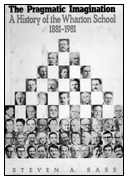In 1881, an iron manufacturer, Joseph Wharton, offered the University of Pennsylvania a donation of $100,000 for the creation of the Wharton School of Finance and Commerce. The first marketing course, “Marketing Products,” was not offered until 1904, and the field began its continuous development at Wharton with the addition of courses on advertising and salesmanship in 1909. By 1930 undergraduate demand had made marketing the second-largest segment of the curriculum, although professors primarily gave instruction in the “how-to-do-it” of advertising and retail selling.
The Marketing Department was created in 1935 when Reavis Cox was made its first chairman, but Professor Ralph F. Breyer’s work on “channels” became the mainstay of marketing studies at Wharton. Even Cox’s subsequent output on installment buying, marketing of house-building materials, and his major work on Distribution in a High-Level Economy all followed Breyer’s lead in investigating the actual channels of economic flow.
In 1948 Cox and Wroe Alderson wrote a pioneering essay, “Towards a Theory of Marketing,” and two years later they edited an anthology on the subject. With the appointment of Alderson to the Department in 1959, systems theory became the basis for research. As an independent consultant (he never won a Ph.D.), Alderson had created a newsletter, theCost and Profit Outlook, and written a book, Marketing Behavior and Executive Action, which brought useful social science theories rather than institutional economics to the attention of his colleagues. In his six years at Wharton (Alderson died in 1965), he used mathematical models and quantitative techniques to attack such problems as how to analyze consumer tastes, “how much to spend on advertising, how big a sales force to maintain, how to allocate salesmen to accounts, and how to apportion marketing messages across the media.” In 1962 Alderson opened a Management Science Center at Wharton, and with his collaborator, Paul Green, made the center an important part of his M.B.A. course in Marketing Management, giving his students a chance to act as consultants and to practice their various new techniques on real-world problems.
But practical disappointments with modeling surfaced at the end of the 1960’s and the discipline found a more compelling identity in market research. New “psychometric” techniques for measuring consumer tastes and econometric methods for segmenting markets emerged around 1970 and became the salient interests in the field. The young professors whom Alderson recruited led the field into the more sophisticated reaches of market research. Paul Green pioneered in using conjoint analysis in marketing applications; as this psychometric technique developed into the discipline’s most powerful tool for analyzing consumer taste, Professor Green became marketing’s most frequently cited author. Ronald Frank, who joined the faculty in the early 1960’s, became a master of market segmentation, a prominent student of the effects of television, and the third most frequently cited scholar in the field. Within a decade, with the hiring of outstanding faculty members such as Yoram Wind, Thomas Robertson, and Leonard Lodish, Wharton’s Marketing Department boasted great strength in statistical technique and psychometrics. The Department also developed an interest in marketing management in the second half of the 1970’s.
Through the next two decades, Wharton’s Marketing department grew significantly in size and scope. It has come to encompass both the major decision areas in marketing (marketing strategy, product and service design, pricing, design of communication programs, and inter-organizational/distribution arrangements). The department is the most published and most cited among Marketing departments worldwide. Its published research draws on a variety of basic disciplines including decision theory, economics, management science and operations research, psychology, and statistics.
 Note: Much of this information was taken from The Pragmatic Imagination: A History of the Wharton School, 1881-1981 by Stephen A. Sass, University of Pennsylvania Press, Philadelphia, 1982.
Note: Much of this information was taken from The Pragmatic Imagination: A History of the Wharton School, 1881-1981 by Stephen A. Sass, University of Pennsylvania Press, Philadelphia, 1982.
Departmental Information


